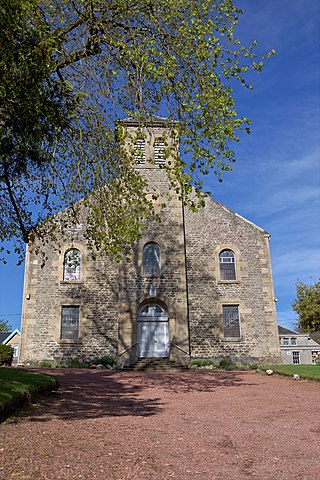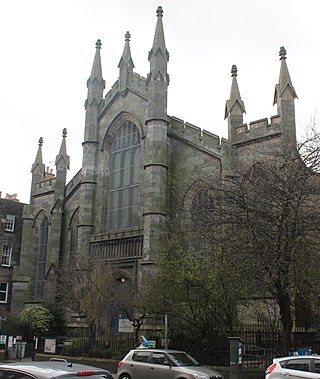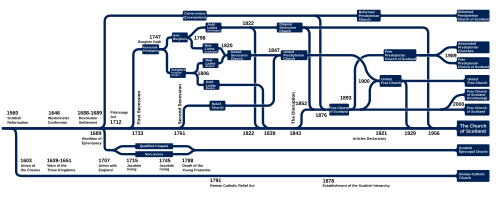
John Jamieson DD was a Scottish minister of religion, lexicographer, philologist and antiquary. His most important work is the Etymological Dictionary of the Scottish Language.

The Free Church of Scotland is a Scottish denomination which was formed in 1843 by a large withdrawal from the established Church of Scotland in a schism known as the Disruption of 1843. In 1900, the vast majority of the Free Church of Scotland joined with the United Presbyterian Church of Scotland to form the United Free Church of Scotland. In 1904, the House of Lords judged that the constitutional minority that did not enter the 1900 union were entitled to the whole of the church's patrimony, the Free Church of Scotland acquiesced in the division of those assets, between itself and those who had entered the union, by a Royal Commission in 1905. Despite the late founding date, Free Church of Scotland leadership claims an unbroken succession of leaders going all the way back to the Apostles.

Adam Gib was a Scottish religious leader, head of the Antiburgher section of the Scottish Secession Church. He reportedly wrote his first covenant with God in the blood of his own veins. Gib was born in the parish of Muckhart, in southern Perthshire on 15 April 1714.

Ebenezer Erskine was a Scottish minister whose actions led to the establishment of the Secession Church.
The United Secession Church was a Scottish Presbyterian denomination which existed between 1820 and 1847.

The Anti-Burghers were opponents of the Burgher Oath on theological grounds.

The Five Articles of Perth was an attempt by King James VI of Scotland to impose practices on the Church of Scotland in an attempt to integrate it with those of the Church of England. This move was unpopular with those Scots who held Reformed views on worship, and with those who supported presbyterian church governance.

Thomas M'Crie was a Scottish biographer and ecclesiastical historian, writer, and preacher born in the town of Duns, and educated at the University of Edinburgh. He became the leading minister of the Original Secession Church. His work: "Life of Knox" (1813) was a means of vindicating the Scottish reformer John Knox who was a unpopular figure at the time. It was followed by a "Life of Andrew Melville" (1819). Melville was Knox's successor as the leader of the Reformers in Scotland. M'Crie also published histories of the Reformation in Italy and Spain. He received an honorary degree of D.D. in 1813, the first Secession minister to receive such an award.

Thomas M'Crie was a Presbyterian minister and church historian. He was a Scottish Secession minister who joined the Free Church of Scotland and served as the Moderator of the General Assembly to that church 1856/57.

Abbeygreen Church is a congregation of the Free Church of Scotland in the small town of Lesmahagow, Lanarkshire. As a Christian congregation, it is presbyterian and reformed; holding the Word of God, the Holy Bible, as the supreme rule of life and doctrine and the Westminster Confession of Faith as a sub-ordinate standard, which helps explain the doctrines of the Christian faith. Being Presbyterian, it serves as part of the Free Church of Scotland Presbytery of Glasgow and seeks to faithfully serve God in Lesmahagow and the surrounding area. Having a missional outlook it is involved with a number of missionary organizations including, but not only, UFM Worldwide and Rose of Sharon Ministries, and helps with the organization and support of the Scottish Reformed Conference.

The First Secession was an exodus of ministers and members from the Church of Scotland in 1733. Those who took part formed the Associate Presbytery and later the United Secession Church. They were often referred to as Seceders.
Archibald Bruce (1746–1816), was a Scottish theological writer.
The Secession Synod was the Presbyterian Synod of Ireland from 1743 to 1840.
In the Scottish church of the 18th and 19th centuries, a burgher was a person who upheld the lawfulness of the burgess oath.

George Paxton was a Scottish secession minister and poet. He was the professor of divinity of the 'New Licht' Anti-Burgher General Associate Synod.

The Southside Community Centre is a community centre in the Southside, Edinburgh, Scotland, United Kingdom. The centre opened in 1986 and occupies the former Nicolson Street Church, which was completed in 1820.

John Reid was a Presbyterian minister from Scotland who was also active in England and Australia. Born in Ayrshire, he was ordained into the United Secession Church in 1829, but later led independent and Burgher churches. He joined the established Church of Scotland in 1839, and in 1845 took over an expatriate congregation in Liverpool, England. Reid immigrated to Australia in 1852, living in Melbourne until 1858 and then in Sydney. He left the Church of Scotland and for a while ministered in John Dunmore Lang's schismatic sect, eventually ending his career at a non-denominational Bethel Union congregation. His son George Reid became the fourth Prime Minister of Australia.
William Wilson was born in Glasgow, on 9 November 1690. He was the son of Gilbert Wilson, proprietor of a small estate near East Kilbride.. William Wilson's mother was Isabella, daughter of Ramsay of Shielhill. William was named after William of Orange and was educated at University of Glasgow, graduating with an M.A. in 1707. He was licensed by the Presbytery of Dunfermline on 23 September 1713 and called unanimously on 21 August 1716. He was ordained on 1 November 1716. He had a call to Rhynd, but was continued by the Presbytery in Perth. Associating with the supporters of the Marrow of Modern Divinity, he with three others Ebenezer Erskine, Alexander Moncrieff, and James Fisher laid the foundation of the Secession Church, for which they were suspended by the Commission of Assembly 9 August, and declared no longer ministers of the Church 12 November 1733. He was deposed by the Assembly 15 May 1740. He and his people erected a meeting-house, and the Associate Presbytery appointed him their Professor of Divinity, 5 November 1736, but he sank under his contentions and labours and died 8 October 1741. He is said to have combined "the excellencies of both Erskines, with excellencies peculiar to himself."

Life Church is a congregation of the Apostolic Church located in the Southside, Edinburgh, Scotland. The church's building was constructed for a congregation of Auld Licht Anti-Burghers in 1813.

George Lawson D.D. (1749–1820) was a Scottish minister of the Secession Church, known as a biblical scholar. Thomas Carlyle, in an 1870 letter to Lawson's biographer John Macfarlane, called him "a most superlative steel-grey Scottish peasant ".















